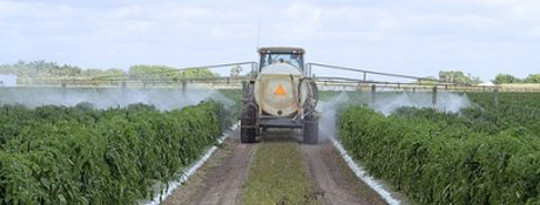
Scientists and government regulators have long identified many common substances that are neurotoxic in high concentrations, including lead and mercury, and have worked to minimize harm to human communities. But there are many chemicals that may affect the human central nervous system and brain functioning that have not been fully tested, and scientists continue to expand the list of harmful substances.
Many widely used herbicides and pesticides also have neurotoxic properties, including the weed killer glyphosate (sold by Monsanto under the brand name Roundup) and the neonicotinoid insecticide Imidacloprid. While less toxic to mammals than earlier crop treatments, both can have wider effects; of particular concern is the potential link of neonicotinoid insecticides to bee colony collapse disorder.
A highly influential and heavily cited 2006 study by Philippe Grandjean and Philipp J. Landrigan analyzed a range of industrial chemicals and classified five as development neurotoxins. A related 2012 study in Environmental Health Perspectives used data from 344 mother/child pairings to measure the relationship between a child’s levels of prenatal pesticide exposure and her gestational age and birthweight. The study found that higher levels of insecticides were associated with shorter pregnancies and lower birthweight.
In February 2014 Grandjean and Landrigan followed their 2006 work with a study in The Lancet titled “Neurobehavioral Effects of Development Toxicity.” The scholars, based at the University of Southern Denmark and the Harvard School of Public Health, review recent empirical studies on development neurotoxins and suggest a path forward for policy makers.
Get The Latest By Email
The Key Findings From The Study Include:
- Evidence confirms the severity of brain damage caused by early childhood exposure to lead, methylmercury, arsenic, polychlorinated biphenyls and ethanol (alcohol). In addition, new studies have added manganese, fluoride, chlorpyrifos, tetrachloroethylene, dichlorodiphenyltrichloroethane and the polybrominated diphenyl ethers to the list of development neurotoxins.
- Exposure to development neurotoxins can cause permanent, untreatable brain damage and results in reduced IQ scores and disruption in behavior. “A recent study compared the estimated total IQ losses from major paediatric causes and showed that the magnitude of losses attributable to lead, pesticides and other neurotoxicants was in the same range as, or even greater than, the losses associated with medical events such as preterm birth, traumatic brain injury, brain tumours and congenital heart disease.”
- Recent estimates indicate that “the annual costs of childhood lead poisoning are about US$50 billion and that the annual costs of methylmercury toxicity are roughly US$5 billion” in the United States. In France, “lead exposure is associated with IQ losses that correspond to annual costs that might exceed €20 billion”.
- Antisocial behavior such as violence and criminality have been associated with early-life exposure to development neurotoxins. The authors note: “In the USA, the murder rate fell sharply 20 years after the removal of lead from petrol, a finding consistent with the idea that exposure to lead in early life is a powerful determinant of behavior decades later. Although poorly quantified, such behavioral and social consequences of neuro-developmental toxicity are potentially very costly.”
- Given the high health care and societal costs associated with exposure to development neurotoxins, better prevention would be cost-effective: “The introduction of lead-free petrol has generated an economic benefit of $200 billion in each annual birth cohort since 1980, an aggregate benefit in the past 30 years of over $3 trillion. This success has since been repeated in more than 150 countries, resulting in vast additional savings. Every US$1 spent to reduce lead hazards is estimated to produce a benefit of US$17-220, which represents a cost-benefit ratio that is even better than that for vaccines.”
“Very few chemicals have been regulated as a result of developmental neurotoxicity,” Grandjean and Landrigan write. “The presumption that new chemicals and technologies are safe until proven otherwise is a fundamental problem.” As in their 2006 review, the authors reiterate their concern “that children worldwide are being exposed to unrecognised toxic chemicals that are silently eroding intelligence, disrupting behaviours, truncating future achievements, and damaging societies, perhaps most seriously in developing countries.”
Related research: A 2011 study published in Environmental Impact Assessment Review, “Fragranced Consumer Products: Chemicals Emitted, Ingredients Unlisted,” analyzed 25 scented household products, including laundry and dish detergents, fabric softeners, cleaners, soaps, disinfectants, hand sanitizers, lotions, deodorants and shampoos. The researchers found that the products emitted more than 130 different volatile organic compounds. Of these, “24 are classified as toxic or hazardous under U.S. federal laws, and each product emitted at least 1 of these compounds.”
This article originally appeared on the Journalist's Resource







